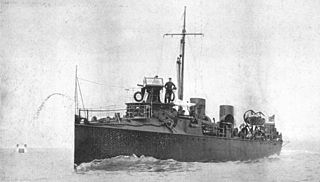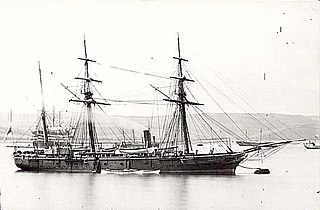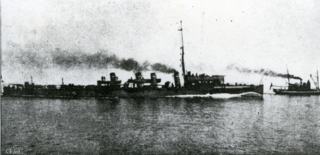Ships and boats
Some early boats are not yet documented online. A large part of the information has been provided by the Miramar Ship Index (www.miramarshipindex.org.nz) through a Wikipedia partnership. However, the official lists of vessels built by Thornycroft (at both Chiswick and at Woolston) are available in the unpublished (but officially recognised) Thornycroft List of 1981 researched and compiled by the late David Lyon with assistance of Thornycroft personnel and the company's archives.
| Completed | Name | Yard No | Tonnage | Description | Illustration |
|---|---|---|---|---|---|
| 1862 | Nautilus | #1 | This small steam launch of 9.5 knots was Thornycroft's first vessel, begun in 1859, when he was just 16. In 1862 it was the only boat that was able to follow the rovers of the University race, giving Thornycroft some publicity. [1] |  | |
| 1863 | Ariel | #2 | There may have been two Ariels. Banbury (page 283) lists a wooden launch as Yard No. 2, while The Engineer of 4 November 1870 describes a steel yacht "built some time ago". [2] | ||
| 1863 | unnamed punt | #3 | 10 ft works Punt. | ||
| 1863 | Slaney | #4 | Steam launch. The Royal Museums at Greenwich have the plans, but not much else is available online. [3] | ||
| 1866 | Waterlily | #5 | Iron launch, capable of 7.8 knots. Preserved as part of the National Historic Fleet. It was used by Thomas Thornycroft, father of John I. Thornycroft. [4] [5] [6] | ||
| 1866 | Idler | #6 | Steam Launch. The Royal Museums at Greenwich have the plans, but not much else is available online. [7] | ||
| 1870 | Swallow | #7 | Capable of 16.2 knots. [8] | ||
| 1870 | Scolopendra | #8 | Steam launch. Apparently a sister to Cygnet. The Royal Museums at Greenwich have the plans, but not much else is available online. [9] | ||
| 1870 | Cygnet | #9 | 1.5 | Small steam launch, preserved and displayed by The Tamesis Trust. [10] | |
| 1871 | Miranda | #10 | 3.7 | A fast steam yacht with lines that set the precedent for torpedo boats in the following years. [11] | |
| 1871 | Canopus | #11 | Open launch. The Royal Museums at Greenwich have the plans, but not much else is available online. [12] | ||
| 1872 | Belvedere | #12 | Capable of 15.6 knots. [13] | ||
| 1872 | Sphinx | #13 | |||
| 1872 | O.E.A. | #15 | Launch of 15 metres (50 ft) or 17 metres (57 ft), capable of 14¾ knots. [14] | ||
| 1872 | Maid of All Work or Maid of Homour | #16 | Open launch, capable of 10.5 knots. [15] | ||
| 1872 | Sylvia | #17 | Boat of 14 metres (45 ft), capable of 10.5 knots. [16] | ||
| 1873 | Sir Arthur Cotton | #18 | A fast launch, cited at 21.4 knots and claimed in 1874 to be the fastest vessel in the world. [17] [18] | ||
| 1873 | Firefly | #14 | There was more than one Firefly (#14 & #19) plus two further vessels of the #19 design. Engineering had two articles in 1873 about a vessel from that year, length 16 metres (53 ft) and with a speed of 16.46 knots (18.94 mph). [19] The 1873 yacht was apparently sold to Russia and converted into a torpedo boat. [20] [21] |  | |
| Firefly | #19 | ||||
| Yard No. 20 | #20 | ||||
| Yard No. 21 | #21 | ||||
| 1874 | unnamed punt | #22 | |||
| 1873 | Rap | #23 | 10 | The Norwegian torpedo boat Rap (Known as the Maelstrom [22] before delivery) was the first in a long series of small fast boats built of steel for naval service. The boat has been preserved at the Royal Norwegian Navy Museum at Horten. |  |
| 1874 | unnamed launch | #24 | |||
| 1874 | Admiralty No.58 | #25 | A pinnace for the Royal Navy, capable of 9.2 knots. [23] | ||
| 1874 | Choutka | #26 | Built of steel and capable of 16.9 knots. Bought by Russia and served as a torpedo boat. [24] |  | |
| 1874 | #Dragonfly | #27 | Launch, capable of 18 knots. [25] | ||
| 1874 | Minnie | 30 | Launch yachts. The Royal Museums at Greenwich have the plans, but not much else is available online. [26] | ||
| Gamecock | 31 | ||||
| 1874 | Eva | 34 | Launch, ordered by the Henley Royal Regatta as an umpire's launch. Used 1874–1876 and then sold. The 14-metre (45 ft) long vessel was built of iron and quoted at 13 knots (15 mph). The photo shows her being restored at the Kew Steam Museum. Since 1996 part of the River & Rowing Museum at Henley. [27] |  | |
| 1874 | Marie | 35 | Launch Yacht. The Royal Museums at Greenwich have the plans, but not much else is available online. [28] | ||
| 1874 | Wildfire | 36 | Launch Yacht. The Royal Museums at Greenwich have the plans, but not much else is available online. [29] | ||
| 1875 | Spring | 29 | 15 | The first Swedish torpedo boat, and like Rap designed for spar torpedoes. [30] |  |
| 1875 | Torpedoboot I | 32 | 10 | A spar torpedo boat for Austria-Hungary. Gogg gives it speed as 13 knots, while Banbury credits it with 18.2 knots. [31] [32] | 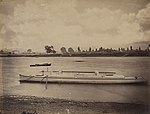 |
| 1875 | Dampchalup Nr. 5 | 33 | 8 | A third Rap-type vessel, this time for Denmark. The proposed armament with spar torpedoes never materialized, and instead it was first supplied with towed torpedoes and later with dropping gear for two 35 cm (14-inch) torpedoes. [33] |  |
| 1876 | Gitana | 37 | This fast yacht was built for Baroness A. de Rothschild and intended for service on Lake Geneva. The 27-metre (90 ft) long vessel did 20.76 knots (23.89 mph) on her trials. [34] |  | |
| 1876 | Torpilleur 5 | 43 | 12 | Two spar torpedo boats for France, capable of 18 knots. [35] | |
| Torpilleur 6 | 44 | 12 | |||
| 1876 | Torpedoboot I | 48 | 20 | A spar torpedo boat for The Netherlands, capable of 18 knots. [36] | |
| 1877 | HMS Lightning | 47 | 32 | Initially equipped with spar torpedoes, from 1879 with a torpedo tube. Speed 18.5 knots. [37] The 25.8 metres (84.6 ft) (26.5 metres (87.0 ft) overall) design was close to that of Gitana. |  |
| 1877 | Torpediniere I | 60 | 30 | This boat for Italy was briefly described in Engineering on 8 June 1877 as being considered for Whitehead torpedoes. But it seems that a spar torpedo installation was chosen instead. [38] [39] | |
| 1878 | Torpilleur 8 | 54 | 26 | A series of spar torpedo boats for France. Measuring 26.6 metres (87.2 ft) overall, they were similar to HMS Lightning. The Engineer reported the speed trials for the first six, ranging from 18.4 to 19.4 knots. Number 10, 16 and 19 were later fitted with torpedo tubes. [40] [41] |  |
| 1878 | Torpilleur 9 | 55 | 26 | ||
| 1878 | Torpilleur 10 | 56 | 26 | ||
| 1878 | Torpilleur 11 | 57 | 26 | ||
| 1878 | Torpilleur 12 | 58 | 26 | ||
| 1878 | Torpilleur 13 | 59 | 26 | ||
| 1878 | Torpilleur 14 | 63 | 26 | ||
| 1878 | Torpilleur 15 | 64 | 26 | ||
| 1878 | Torpilleur 16 | 65 | 26 | ||
| 1878 | Torpilleur 17 | 66 | 26 | ||
| 1878 | Torpilleur 18 | 67 | 26 | ||
| 1878 | Torpilleur 19 | 68 | 26 | ||
| 1878 | Torpedoboot II | 69 | 28 | A torpedo boat for Austria-Hungary, and their first with torpedo tubes. At 26.5 metres (87.0 ft) it was similar in size to the French series of boats. Gogg gives it speed as 15 knots, while Chesneau credits it with 18.2 knots. [42] [43] | |
| 1878 - 1879 | HMTB 2 | 71 | 28 | A series of torpedo boats for the Royal Navy. Measuring 26.3 metres (86.4 ft), they were almost identical to HMS Lightning (which was renamed HM TB 1), except that the Gitana-style cabin roof was discarded. They had a trainable torpedo tube on the bow, but that was later replaced by dropping gear for two torpedoes midships. [44] |  |
| HMTB 3 | 72 | 28 | |||
| HMTB 4 | 73 | 28 | |||
| HMTB 5 | 74 | 28 | |||
| HMTB 6 | 75 | 28 | |||
| HMTB 7 | 76 | 28 | |||
| HMTB 8 | 77 | 28 | |||
| HMTB 9 | 78 | 28 | |||
| 1879 | HMTB 10 | 79 | 28 | A variation of the Lightning design with a ram bow, making the boat longer (27.9 metres (91.5 ft) overall). [45] [46] | |
| 1878 - 1879 | HMTB 11 | 80 | 28 | Two more of the HMTB 2 design. [47] | |
| HMTB 12 | 81 | 28 | |||
| 1878 - 1879 | HMTB 51 | 82 | 11 | A series of smaller torpedo boats (introducing the concept of second class torpedo boats) for the Royal Navy. They carried their two torpedoes in dropping gear midships. [48] |  |
| HMTB 52 | 83 | 11 | |||
| HMTB 53 | 84 | 11 | |||
| HMTB 54 | 85 | 11 | |||
| HMTB 55 | 86 | 11 | |||
| HMTB 56 | 87 | 11 | |||
| HMTB 57 | 88 | 11 | |||
| HMTB 58 | 89 | 11 | |||
| HMTB 59 | 90 | 11 | |||
| HMTB 60 | 91 | 11 | |||
| HMTB 61 | 92 | 11 | |||
| HMTB 62 | 93 | 11 | |||
| 1878 - 1879 | Torpedoboot IV | 94 | 20 | A series of spar torpedo boats for the Royal Netherlands Navy. Measuring 24.1 metres (79.0 ft), they were slightly larger versions of the Torpedoboot I design. [49] | |
| Torpedoboot V | 95 | 20 | |||
| Torpedoboot VI | 96 | 20 | |||
| Torpedoboot VII | 97 | 20 | |||
| Torpedoboot VIII | 98 | 20 | |||
| Torpedoboot IX | 99 | 20 | |||
| 1878 | Vril | 103 | Open launch. The Royal Museums at Greenwich have the plans, but not much else is available online. [50] | ||
| 1879 | Torpilleur 29 | 100 | 8 | The first batch of second class torpedo boats (Torpilleurs-vedettes) for France, capable of 16 knots. They measured 18.4 metres (60.4 ft) [51] [52] | |
| Torpilleur 30 | 101 | 8 | |||
| 1879 | Torpedobaad Nr. 4 | 102 | 33 | A development of the Lightning design for the navy of Denmark, 27.8 metres (91 ft), with a torpedo tube in the bow. Named Hajen in 1882. [53] | 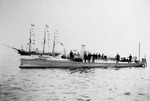 |
| 1880 - 1881 | HMTB 64 | 104 | 13 | A series of second class torpedo boats for the Royal Navy. Measuring 19.2 metres (63.0 ft) and fitted with dropping gear for two torpedoes. [54] | |
| HMTB 65 | 105 | 13 | |||
| HMTB 66 | 106 | 13 | |||
| HMTB 67 | 107 | 13 | |||
| HMTB 68 | 108 | 13 | |||
| HMTB 69 | 109 | 13 | |||
| HMTB 70 | 110 | 13 | |||
| HMTB 71 | 111 | 13 | |||
| HMTB 72 | 112 | 13 | |||
| HMTB 73 | 113 | 13 | |||
| 1880 | Kefal | 116 | 13 | A small torpedo boat for Russia. [55] | |
| 1881 | Torpedera No 1 | 114 | 11 | Two spar torpedo boats for Argentina, 18.9 metres (62.1 ft) and 16 knots. [56] The histarmar.com.ar website dates them to 1882 and credits them with 15.0 knots. [57] |  |
| Torpedera No 2 | 115 | 11 | |||
| 1880 - 1882 | HMTB 76 | 117 | 12 | Another series of second class torpedo boats for the Royal Navy, this time with two torpedo tubes side by side in the bows. [58] | |
| HMTB 77 | 118 | 12 | |||
| HMTB 78 | 119 | 12 | |||
| HMTB 79 | 120 | 12 | |||
| HMTB 80 | 121 | 12 | |||
| HMTB 81 | 122 | 12 | |||
| HMTB 82 | 123 | 12 | |||
| HMTB 83 | 124 | 12 | |||
| HMTB 84 | 125 | 12 | |||
| HMTB 85 | 126 | 12 | |||
| HMTB 86 | 127 | 12 | |||
| HMTB 87 | 128 | 12 | |||
| HMTB 88 | 129 | 12 | |||
| HMTB 89 | 130 | 12 | |||
| HMTB 90 | 131 | 12 | |||
| HMTB 91 | 132 | 12 | |||
| HMTB 92 | 133 | 12 | |||
| HMTB 93 | 134 | 12 | |||
| HMTB 94 | 135 | 12 | |||
| HMTB 95 | 136 | 12 | |||
| 1881 | Torpilleur 58 | 137 | 10 | Second class torpedo boats (Torpilleurs-vedettes) for France, capable of 16 knots. They measured 18.4 metres (60.4 ft) [59] [60] | |
| Torpilleur 59 | 138 | 10 | |||
| 1881 | Aquila | 139 | 34 | Two torpedo boats for Italy, later named 23T and 24T. They measured 29 metres (96 ft) and had two 14-inch torpedo tubes. [61] [62] |  |
| Gabbiano | 140 | 34 | |||
| 1881 | Torpedobaad Nr. 6 | 142 | 58 | This torpedo boat for Denmark marked a significant increase in the size of Thornycroft's designs. It measured 33.5 metres (110.0 ft), was capable of 20.7 knots and had two torpedo tubes of the large 38 cm (15-inch) type in the bows. Named Sværdfisken in 1882. [63] | 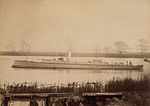 |
| 1882 - 1883 | Aldebaran | 143 | 38 | A series of torpedo boats for Italy. They measured 30.5 metres (100.0 ft), did 21.4 knots on trials and had two 14-inch torpedo tubes in the bows. In 1886 they were renamed 26T-35T. [64] [65] |  |
| Antares | 144 | 38 | |||
| Andromeda | 145 | 38 | |||
| Centauro | 146 | 38 | |||
| Dragone | 147 | 38 | |||
| Pegaso | 148 | 38 | |||
| Perseo | 149 | 38 | |||
| Sagittario | 150 | 38 | |||
| Sirio | 151 | 38 | |||
| Orione | 152 | 38 | |||
| 1882 | Tb 2. kl. Nr. 4 | 153 | 15 | Two second class torpedo boats for Denmark. They measured 18.9 metres (62.1 ft) and had two 14-inch torpedo tubes. Compared to the boats of the Royal Navy the intricate steam firing system for the torpedoes had been replaced by compressed air. [66] | |
| Tb 2. kl. Nr. 5 | 154 | 15 | |||
| 1882 | Peace | 155 | A shallow draught mission steamer for service on the Congo River. It measured 21.3 metres (70.0 ft) and did 10.4 knots on trials. It was important to the yard, being the first vessel built there with watertube boilers. The boilers on the Peace were of the Herreshoff design, but John Thornycroft patented his own design in 1885 and they took over from the previous locomotive boilers. [67] |  | |
| 1882 | Seid | 157 | 45 | A torpedo boat for the Swedish Navy. It measured 30.5 metres (100 ft) and was equipped with two 14-inch torpedo tubes in the bows. [68] | |
| 1883 | HMTB 98 | 141 | 14 | A special second class torpedo boat for the Royal Navy, equipped with the Ruthven system of water jet propulsion. The system was a disappointment, making the boat slower (12.6 knots), while raising the noise level of the engines considerably. [69] |  |
| 1883 | Euterpe | 158 | 13 | The first series of second class torpedo boats for Italy. They measured 19.2 metres (63.0 ft), did 17.3 knots on trials and had two 14-inch torpedo tubes in the bows. In 1886 they were renamed 3T-10T. [70] |  |
| Talia | 159 | 13 | |||
| Erato | 160 | 13 | |||
| Melpomene | 161 | 13 | |||
| Terpsicore | 162 | 13 | |||
| Polimnia | 163 | 13 | |||
| Urania | 164 | 13 | |||
| Calliope | 165 | 13 | |||
| 1883 | Sukhum | 167 | 64 | This torpedo boat for Russia was the largest yet from Thornycroft. It measured 34.4 metres (113.0 ft), did 19.5 knots on trials and had two torpedo tubes of the large 38 cm (15-inch) type in the bows. [71] |  |
| 1883 | Defender | 168 | 12 | A series of spar torpedo boats for New Zealand. They arrived in 1884 and the following year three sets of dropping gear for torpedoes was acquired for them. [72] |  |
| Taiaroa | 169 | 12 | |||
| Waitemata | 170 | 12 | |||
| Poneke | 171 | 12 | |||
| 1883 - 1884 | Mosca | 173 | 16 | A series of second class torpedo boats for Italy. They were armed with two 14 inch torpedo tubes in the bows and were 20.1 metres (66.0 ft) long. In 1886 they were renamed 12T-15T. [73] |  |
| Ape | 174 | 16 | |||
| Vespa | 175 | 16 | |||
| Farfalla | 176 | 16 | |||
| 1883 | Lucciola | 177 | 13 | A further six units of the Euterpe class for Italy. They were armed with two 14 inch torpedo tubes in the bows and were 19.2 metres (63.0 ft) long. In 1886 they were renamed 16T-21T. [74] |  |
| Formica | 178 | 13 | |||
| Cicala | 179 | 13 | |||
| Locusta | 180 | 13 | |||
| Grillo | 181 | 13 | |||
| Zanzara | 182 | 13 | |||
| 1883 | Delfinen | 183 | 67 | A torpedo boat for the Navy of Denmark. It measured 33.7 metres (110.5 ft), did 20.0 knots on trials and had two torpedo tubes of the large 38 cm (15-inch) type in the bows. [75] |  |
| 1883 | Alfa | 184 | 4 | Three small launches for naval service on the rivers of Brazil. Measuring 13.7 metres (45 ft), they were armed with one spar torpedo, and credited with a speed of 12 knots. [76] [77] [78] |  |
| Beta | 185 | 4 | |||
| Gama | 186 | 4 | |||
| 1883 | "River Gunboat" | 187 | Two river gunboats for Brazil. The Royal Museums at Greenwich have the plans, but not much else is available online. [79] | ||
| "River Gunboat" | 188 | ||||
| 1884 | HMVS Childers | 172 | 65 | A torpedo boat for the Colony of Victoria. It measured 34.4 metres (113.0 ft), did 19.1 knots on trials and had two 35 cm (14-inch) torpedo tubes in the bows. It made the trip to Australia under own power. [80] |  |
| 1884 | HMVS Nepean | 189 | 13 | Two second class torpedo boats for the Colony of Victoria. They were identical to the early second class units of the Royal Navy, with dropping gear midships for two 14-inch torpedoes. They measured 18.9 metres (62.1 ft) and did 17.6 knots on trials. [81] | |
| HMVS Lonsdale | 190 | 13 | |||
| 1884 | TB 191 | 191 | 13 | A torpedo boat for the Colony of Tasmania. It measured 18.9 metres (62.1 ft) and did 17.2 knots on trials. It was a sister to the boats for New Zealand, and – like them – it originally had spar torpedoes, replaced in 1885 by dropping gear. The name Wasp is used on miramarshipindex.org.nz, but not seen elsewhere. [82] | 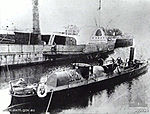 |
| 1884 | Jumbo | 192 | Steel rowing boat for the Thornycroft yard. [83] | ||
| 1884 | Th 2 | 194 | 13 | A second class torpedo boat for the Imperial German Navy. It was of Thornycroft's standard design of the day with two 14-inch torpedoes, measured 19.2 metres (63.0 ft) and did 15.5 knots on trials. [84] | |
| 1884 | Hugin | 195 | 60 | A first class torpedo boat for the Royal Swedish Navy. It carried two 38 cm (15-inch) torpedo tubes, measured 34.4 metres (113.0 ft) and did 19.2 knots on trials. [85] [86] |  |
| 1884 | "Steam Launch" | 196 | Steam launch for Brazil. The Royal Museums at Greenwich have the plans, but not much else is available online. [87] | ||
| 1884 | Th 1 | 197 | 80 | A large torpedo boat for the Imperial German Navy. It carried two 14-inch torpedo tubes, measured 35.9 metres (117.8 ft) and did 19.9 knots on trials. [88] |  |
| 1884 | Hvalrossen | 198 | 74 | A first class torpedo boat for the Royal Danish Navy. It carried two 38 cm (15-inch) torpedo tubes, measured 34.7 metres (114.0 ft) and did 18.7 knots on trials. [89] [90] |  |
| 1884 | Tb 2. kl. Nr. 6 | 199 | 15 | Two second class torpedo boats for Denmark. They measured 20.1 metres (66.0 ft) and had two 14-inch torpedo tubes. The trial speed was 15.1 knots [91] | |
| Tb 2. kl. Nr. 7 | 200 | 15 | |||
| 1884 | "Open Launch" | 203 | Open launch. The Royal Museums at Greenwich have the plans, but not much else is available online. [92] | ||
| 1884 | Khatadbah | 205 | River launch. The Royal Museums at Greenwich have the plans, but not much else is available online. [93] | ||
| 1885 | HMQS Mosquito | 193 | 13 | A torpedo boat for the Colony of Queensland. It measured 18.9 metres (62.1 ft) and did 17.2 knots on trials. It was a sister to the boats for New Zealand, but had dropping gear for two 35 cm (14-inch) torpedoes from the outset. [94] |  |
| 1885 | HMTB 21 | 201 | 64 | These two torpedo boats for the Royal Navy were based on HMVS Childers and had a similar measurement of 34.6 metres (113.6 ft). The trial speed was 19.8 knots [95] |  |
| HMTB 22 | 202 | 64 | |||
| 1885 | Queen of the Vale | 206 | Shallow-draught yacht. The Royal Museums at Greenwich have the plans, but not much else is available online. [96] |  | |
| 1885 | Julián Ordóñez | 209 | 66 | Two torpedo boats for the Navy of Spain, measurement of 34.6 metres (113.6 ft). The trial speed was 19.8 knots [97] | |
| Acevedo | 210 | 66 | |||
| 1885 | Albert | 213 | 100 | Five Nile river steamers with a measurement of 42.7 metres (140.0 ft) and a trial speed of 15.1 knots. Miramarshipindex.org.nz calls the last unit Leopold. [98] |  |
| Arthur | 214 | 100 | |||
| Alfred | 215 | 100 | |||
| Clarence | 216 | 100 | |||
| Patrick | 217 | 100 | |||
| 1886 | HMTB 99 | 207 | 12 | Two second class torpedo boats for the Royal Navy. They measured 19.5 metres (64.0 ft) and had a trial speed of 16.1 knots. No. 100 was the first to have watertube boilers of Thornycrofts own design. [99] | |
| HMTB 100 | 208 | 12 | |||
| 1886 | Sabino Vieira | 211 | 16 | Second class torpedo boat for Brazil. Because of a lack of yard number/name coordination this might also be yard no. 196 (or 187–188). One 35 cm (14-inch) torpedo tube in the bows. [100] |  |
| 1886 | HMTB 25 | 212 | 60 | First class torpedo boat for the Royal Navy. It had a "bull nose" design of the bows that turned out to be unsatisfactory. It measured 38.9 metres (127.6 ft) and did 19.4 knots on trials. [101] [102] | |
| 1886 | HMTB 26 | 218 | 60 | A series of first class torpedo boats for the Royal Navy. They were based on the HMTB 25 but had a straight bow. [103] |  |
| HMTB 27 | 219 | 60 | |||
| HMTB 28 | 220 | 60 | |||
| HMTB 29 | 221 | 60 | |||
| HMTB 41 | 222 | 60 | |||
| HMTB 42 | 223 | 60 | |||
| HMTB 43 | 224 | 60 | |||
| HMTB 44 | 225 | 60 | |||
| HMTB 45 | 226 | 60 | |||
| HMTB 46 | 227 | 60 | |||
| HMTB 47 | 228 | 60 | |||
| HMTB 48 | 229 | 60 | |||
| HMTB 49 | 230 | 60 | |||
| HMTB 50 | 231 | 60 | |||
| HMTB 51 | 232 | 60 | |||
| HMTB 52 | 233 | 60 | |||
| HMTB 53 | 234 | 60 | |||
| HMTB 54 | 235 | 60 | |||
| HMTB 55 | 236 | 60 | |||
| HMTB 56 | 237 | 60 | |||
| HMTB 57 | 238 | 60 | |||
| HMTB 58 | 239 | 60 | |||
| HMTB 59 | 240 | 60 | |||
| HMTB 60 | 241 | 60 | |||
| 1886 | Assynt | 242 | Steam yacht. The Royal Museums at Greenwich have the plans, but not much else is available online. [104] | ||
| 1886 | Tb 2. kl. Nr. 8 | 243 | 15 | Two second class torpedo boats for Denmark. They measured 21.2 metres (69.6 ft) and had two 14-inch torpedo tubes. The trial speed was 15.5 knots [105] |  |
| Tb 2. kl. Nr. 9 | 244 | 15 | |||
| 1886 | "Steel sailing boat" | 251 | Steel sailing (or steel rowing) boats. The Royal Museums at Greenwich have the plans, but not much else is available online. [106] | ||
| "Steel sailing boat" | 252 | ||||
| 1887 | Habana | 245 | 67 | Torpedo boat for the Navy of Spain. It measured 38.9 metres (127.6 ft) and had two 14-inch torpedo tubes. The trial speed was 21.3 knots [107] | |
| 1887 | Boadicea | 246 | Banbury described her as a triple screw experimental yacht for John Thornycroft. [108] On the other hand, Thornycroft himself referred to her as a single screw vessel, fitted with a turbine propeller for shallow water navigation. He also stated that she was sold to French owners for service on Madagascar. [109] |  | |
| 1887 | Ariete | 247 | 120 | Two first class torpedo boats for Spain. They measured 45.0 metres (147.6 ft) and had two 14-inch torpedo tubes. The trial speed was 26.2 knots and they marked a new increase in the size and speed of the yard's designs. [110] |  |
| Rayo | 248 | 120 | |||
| 1887 | Støren | 249 | 110 | Two first class torpedo boats for the Navy of Denmark. This pair had a traditional ram bow, which made the boats wet at any but the slowest speed. They had two 38 cm (15-inch) torpedo tubes in the bows and two more on the poop. The trial speed was up to 23.3 knots. [111] [112] |  |
| Søløven | 250 | 110 | |||
| 1887 | Pollywog | 261 | Experimental steam launch. The Royal Museums at Greenwich have the plans, but not much else is available online. [113] | ||
| 1888 | Havhesten | 253 | 110 | Two first class torpedo boats for the navy of Denmark. This pair had had a straight stem with the torpedo ports flushed in the bows and that proved to be much better than the Støren boats of the preceding year. They had two 38 cm (15-inch) torpedo tubes in the bows and two more on the poop. The trial speed was up to 22.9 knots. [114] [115] |  |
| Narhvalen | 254 | 110 | |||
| 1888 | Coureur | 255 | 101 | Torpedo boat for the Navy of France. It was "virtually a copy" of the Spanish Ariete. It measured 45.0 metres (147.6 ft) and had two 14-inch torpedo tubes. The trial speed was 23.5 knots [116] [117] |  |
| 1888 | Baluchi | 256 | 96 | Three torpedo boats of the 125 foot type, ordered by the Royal Indian Marine. Apparently they never reached India, but were taken over by the Royal Navy in 1892 as HMT B 100, HMT B 102 and HMT B 103. They measured 41.1 metres (134.7 ft) and had five 14-inch torpedo tubes. The trial speed was 21.9 knots. [118] |  |
| Karen | 257 | 96 | |||
| Pathan | 258 | 96 | |||
| 1888 | Tb 2. kl Nr. 10 | 259 | 16 | Two second class torpedo boats for Denmark. They measured 21.4 metres (70.3 ft) and had two 14-inch torpedo tubes. The trial speed was 15.6 knots. [119] | |
| Tb 2. kl. Nr. 11 | 260 | 16 | |||
| 1888 | Mirim | 262 | River tug launch. The Royal Museums at Greenwich have the plans, but not much else is available online. [120] | ||
| 1889 | Tb 2. kl Nr. 12 | 263 | 25 | Two second class torpedo boats for Denmark. They measured 24.5 metres (80.4 ft) and had two 14-inch torpedo tubes. The trial speed was 17.9 knots. [121] |  |
| Tb 2. kl. Nr. 13 | 264 | 25 | |||
| 1889 | Georgie | 265 | Steam launch for Louis Meyer, Dresden. The Royal Museums at Greenwich have the plans, but not much else is available online. [122] | ||
| 1889 | Aurora | 266 | River launch yacht, fitted with a special "turbine propeller" for service on shallow rivers. The Royal Museums at Greenwich have the plans. [123] [124] |  | |
| 1889 | "Steel rowing boat" | 269 | Galvanised sailing and rowing boats. The Royal Museums at Greenwich have the plans, but not much else is available online. [125] | ||
| "Steel rowing boat" | 270 | ||||
| 1890 | Boojum | 274 | Steam launch. The Royal Museums at Greenwich have the plans, but not much else is available online. [126] | ||
| 1890 | Bijoli | 275 | River steamer for service in India. Length 42.7 metres (140.0 ft), trial speed 13.9 knots. [127] |  | |
| 1891 | Marcílio Dias | 271 | 110 | Three first class torpedo boats for the Navy of Brazil. Length 45.7 metres (150.0 ft), trial speed 25.9 knots. Naval.com.br refer to them as "tipo Coureur", the torpedo boat built for France. [128] [129] [130] |  |
| Iguatemi | 272 | 110 | |||
| Araguari | 273 | 110 | |||
| 1891 | Goodwill | 276 | River passenger steamer. Built for the Baptist Missionary Society. Length 25.7 metres (84.2 ft), trial speed 9.1 knots. Served on the Upper Congo. [131] [132] | 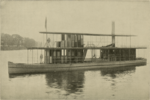 | |
| 1892 | Comodoro Py | 267 | 110 | Two first class torpedo boats for Argentina. Most sources date them to 1890, but histamar.org have them joining the Argentine Navy in 1892. Length 45.7 metres (150.0 ft), trial speed 25.1 knots. [133] [134] |  |
| Comodoro Murature | 268 | 110 | |||
| 1893 | RN Pinnace No 256 | 283 | Four pinnaces for the Royal Navy. Length 12.2 metres (40.0 ft), trial speed 9.2 knots. [135] | ||
| RN Pinnace No 257 | 284 | ||||
| RN Pinnace No 258 | 285 | ||||
| RN Pinnace No 259 | 286 | ||||
| 1893 - 1894 | HMTB 91 | 289 | 141 | Three first-class torpedo boats for the Royal Navy. No. 93 was different from the others, being the first twin-screw torpedo boat in the Royal Navy. Length 43.5 metres (142.6 ft), trial speed 23.7 knots. [136] | |
| HMTB 92 | 290 | 141 | |||
| HMTB 93 | 291 | 141 | |||
| 1894 | HMS Speedy | 281 | 810 | A special unit of the Alarm-class torpedo gunboats with water-tube boilers instead of locomotive-types. This made her almost two knots faster than her sisters. At 810 tons she was the yard's largest vessel so far. Length 73.8 metres (242.0 ft), trial speed 20.5 knots. [137] [138] |  |
| 1894 | Kiran | 300 | 140 | River steamer. Length 42.7 metres (140.0 ft), trial speed 13.0 knots. [139] | |
| 1895 | HMS Daring | 287 | 264 | Thornycroft's part of the Admiralty's 1892 order for 26-knot torpedo boat destroyers. Length 56.4 metres (185.0 ft). Daring did 28.2 knots on trials. [140] [141] |  |
| HMS Decoy | 288 | 264 | |||
| 1895 | HMS Ardent | 297 | 269 | Thornycroft's part of the Admiralty's 1893-94 order for 27-knot torpedo boat destroyers. Length 61.4 metres (201.6 ft). Boxer did 29.1 knots on trials. [142] [143] |  |
| HMS Boxer | 298 | 269 | |||
| HMS Bruiser | 299 | 269 | |||
| 1895 | President van Heel | 304 | Lifeboat for the Netherlands. Length 16.8 metres (55.0 ft), trial speed 9.3 knots. [144] | ||
| 1897 | HMS Desperate | 305 | 372 | Thornycroft's part of the Admiralty's 1894-95 order for 30-knot torpedo boat destroyers. Length 64.0 metres (210.0 ft). Desperate did 30.4 knots on trials. [145] [146] |  |
| HMS Fame | 306 | 272 | |||
| HMS Foam | 307 | 272 | |||
| HMS Mallard | 308 | 272 | |||
| 1897 | Sevillana | 323 | A fast launch. Length 23.0 metres (75.6 ft), trial speed 21.3 knots. [147] | ||
| 1897 | RNLB Queen | 325 | A lifeboat for the Royal National Lifeboat Institution. Length 16.8 metres (55.0 ft), trial speed 8.7 knots. [148] | ||
| 1898 | HMS Angler | 313 | 270 | Thornycroft's part of the Admiralty's 1895-96 order for 30-knot torpedo boat destroyers. Length 64.0 metres (210.0 ft). Ariel did 30.8 knots on trials. [149] [150] |  |
| HMS Ariel | 314 | 270 | |||
| 1898 | D 10 | 322 | 310 | Built for Germany as Divisionsboot 10, this was in fact a variation of the 30-knot RN destroyers, although with lighter guns. Length 64.6 metres (211.9 ft), trial speed 27.7 knots. [151] [152] | |
| 1898 | HMS Woodcock | 326 | 150 | A class of three river gunboats for the Royal Navy. The first two were dismantled and sent to the China station, while Melik was sent to Egypt and assisted in the campaigns of the Mahdist War. Length 44.2 metres (145.0 ft), trial speed up to 13.3 knots. [153] |  |
| HMS Woodlark | 327 | 150 | |||
| HMS Melik | 328 | 150 | |||
| 1899 | Shamrock | 339 | 135 | A racing yacht built for Sir Thomas Lipton. Length 38.8 metres (127.3 ft). [154] |  |
| 1899 - 1900 | HMS Coquette | 319 | 270 | Thornycroft's part of the Admiralty's 1896-97 order for 30-knot torpedo boat destroyers. Length 64.0 metres (210.0 ft). Ariel did 30.8 knots on trials. [155] [156] |  |
| HMS Cygnet | 320 | 270 | |||
| HMS Cynthia | 321 | 270 | |||
| 1900 | HMS Albatross | 318 | 380 | The Admiralty's 1896-97 orders included three special 33-knotters, of which Thornycroft was assigned one. It never reached that speed, and neither did the others. Length 69.2 metres (227.0 ft), trial speed 31.4 knots. [157] [158] | |
| 1898 - 1900 | Murakumo | 329 | 279 | The Murakumo-class destroyers for the Imperial Japanese Navy were based Thornycroft's Angler design for the Royal Navy. Length 64.0 metres (210.0 ft). They did up to 30.5 knots on trials. [159] [160] |  |
| Shinonome | 330 | 279 | |||
| Yūgiri | 331 | 279 | |||
| Shiranui | 332 | 279 | |||
| Kagerō | 337 | 279 | |||
| Usugumo | 338 | 279 | |||
| 1900 | HMS Stag | 334 | 320 | Thornycroft's only destroyer in the Admiralty's 1897-98 orders was HMS Stag. Length 64.0 metres (210.0 ft), trial speed 30.5 knots. [161] [162] |  |
| 1900 | Argus | 342 | 123 | The Navy of France had two river gunboats of the Woodcock design, for service in China. Length 44.2 metres (145.0 ft), trial speed up to 13.7 knots. [163] | |
| Vigilante | 343 | 123 | |||
| 1901 | HMTB 98 | 346 | 188 | The 160-footers were a Thornycroft design for the Royal Navy, based on the 140-footers. Length 48.8 metres (160.0 ft). They did up to 25.8 knots on trials. [164] [165] |  |
| HMTB 99 | 347 | 188 | |||
| HMTB 107 | 351 | 188 | |||
| HMTB 108 | 352 | 188 | |||
| 1901 | Livingstone | 354 | 111 | Stern-wheel river steamer. Length 33.8 metres (111.0 ft), trial speed 9.8 knots. [166] | |
| 1902 | Shirakumo | 356 | 342 | Two Shirakumo-class destroyers for the Imperial Japanese Navy. Length 66.1 metres (216.9 ft), trial speed up to 31.8 knots. [167] [168] |  |
| Asashio | 357 | 342 | |||
| 1902 - 1903 | HMTB 109 | 359 | 200 | Five torpedo boats for the Royal Navy. Were slightly larger versions of the 160-foot design. Length 50.6 metres (166.0 ft). They did up to 25.1 knots on trials. [169] [170] | |
| HMTB 110 | 360 | 200 | |||
| HMTB 111 | 361 | 200 | |||
| HMTB 112 | 362 | 200 | |||
| HMTB 113 | 363 | 200 | |||
| 1903 | Princess of Wales | 365 | Lifeboat. Length 18.0 metres (59.1 ft), trial speed 9.6 knots. [171] | ||
| 1905 | HMS Kennet | 366 | 550 | These four destroyers were Thornycroft's part of the River-class programme for the Royal Navy. Length 68.6 metres (225.0 ft). They did up to 26.0 knots on trials. [172] [173] | 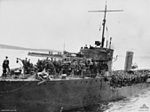 |
| HMS Jed | 367 | 550 | |||
| HMS Chelmer | 371 | 550 | |||
| HMS Colne | 372 | 550 | |||
| 1905 | Naparima | 373 | Shallow-draught steamer for service in the Gulf of Paria, Trinidad. Length 42.7 metres (140.0 ft), trial speed 14.3 knots. [174] [175] |  | |
| 1905 | Magne | 378 | 309 | Destroyer for the Royal Swedish Navy. She was a half-sister of the Yarrow-built Mode with dimensions closely resembling Thornycroft's Shirakumo-class destroyers. Length 66.1 metres (216.9 ft), trial speed 30.6 knots. [176] [177] |  |
| 1905 | Firefly | #397 | ? | Motor launch, 55 feet (17 m) length, possibly intended as a motor lifeboat for the Newhaven branch of the Royal National Lifeboat Association, and probably built at Chiswick. [178] | |
| 1905 | ? | #399 | ? | Tunnel stern launch tug 57 feet (17 m) length, for Henry van During of Shanghai. [179] | |
| 1905 | Emil Capitaine | #405 | ? | Cabin launch, tunnel stern, "gas motor boat" 60 feet (18 m) length, probably built at Chiswick. [180] | |
| 1905 | Pollywog or Roona | #408 | ? | Seagoing motor launch 30 feet (9.1 m) length, built (probably at Chiswick) for Thornycroft stock use - later sold to MacBeth Brothers & Co. [181] | |
| 1905 | Dalmuir | #409 | ? | Cabin launch, tunnel stern, "gas motor boat" 60 feet (18 m) length, probably built at Chiswick for William Beardmore & Co (and a sister to #405). [182] | |
| 1905 | Pollywog or Roona | #411 | ? | Seagoing motor launch 30 feet (9.1 m) length, built (probably at Chiswick) for the Motor Yacht Club. [183] | |
| 1905 | Ambrim | #414 | ? | Open Wooden launch 26 feet (7.9 m) length, built (probably at Chiswick) for A. R. Longridge. [184] | |
| 1906 - 1907 | HMTB 6 | #415 | 255 | Five early vessels of the Cricket-class of coastal destroyers were built by Thornycroft. The first was launched in 1906 as the Gadfly, but then the Admiralty changed its mind and the proposed names for the others were never used. Instead, they became TB 6-10 from 1906. Length 51.2 metres (168.0 ft). They did up to 27.5 knots on trials. [185] [186] |  |
| HMTB 7 | #416 | 255 | |||
| HMTB 8 | #417 | 255 | |||
| HMTB 9 | #418 | 255 | |||
| HMTB 10 | #419 | 255 | |||
| 1905 | ? | #420 | ? | A paddle-steam (sternwheel) launch 33 feet (10 m) o.a. length, built for Nigeria. [187] |







